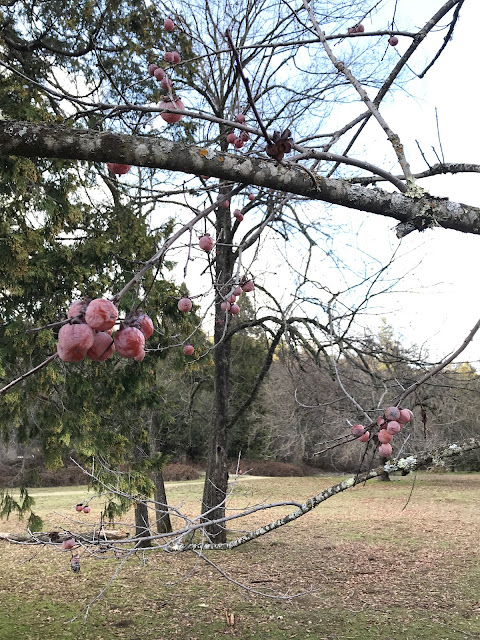Once upon a time the City of Coloma was a thriving international community with the fruit orchards rolling along the hills. Now, in the early 21st century a few survived fruiting trees are still producing there. I first found them in the fall of 2018 and described some in the second issue of the Fruit Gardener magazine in 2019.
Persimmons
The Gold Discovery park in Coloma hosts Diospyros kaki (Asian persimmons) trees growing along the Diospyros virginiana (American persimmons) trees. Both are the exotic trees to the area and came here from different parts of the Earth. There is might be yet another species, as I'm not able to easily place one tree to either of these. Most likely, the Asian persimmons were introduces by the Chinese as they arrived there in 1848 to work in the gold mines. This site has to be one of the first areas to host the Asian persimmons in the US. At the same time the workers from the Eastern US were arriving in masses to support the thriving California gold industry. The American persimmons growing there have to be credited to the workforce arrived from the American East. Below are some pictures of trees and fruits. I named those trees which I am propagating.
American by the Road 49
Very tasty American persimmon growing on a small tree, which is probably a root sprout from the nearby patch/ring of very large and old female trees which themselves seem to be the clones from a tree that was gone a while ago.
Rye Bread
Pollination Variant Non-Astringent Asian persimmon. Very dark flesh with just enough sugar to taste the complexity of the chocolaty-peachy flavors. The fruits are medium-small in size for an Asian persimmon.
Watermelon
Another Pollination Variant Non-Astringent Asian persimmon. The non-pollinated fruits are elongated, while the pollinated ones are round and even squat. These are sweet and chocolate-watermelon flavored.
In this older post Watermelon and Rye Bread are tasted and compared to a few other PVNA persimmons.According to De Moerbeiboom, "The smaller and different shaped fruit always result from male type flowers (clusters of three) that are actually perfect flowers that have both anthers and pistils. Larger female flowers are on the same tree. These will produce normal sized seeded fruit."
In the terms of the flavor and astringency, I preferred the smaller fruits, but in a different year the large fruits were pretty good too.
High Street Apple
This old tree produces very nice sweet yellow apples.
Monroe Pear
This pear tree grows in the area of Monroe family orchard at the park. It produces flavorful, sweet melting fruit.
Mulberries
Old Coloma Black Mulberry, Morus nigra
The scions from the accessions described here will be available (in limited quantities) during the winter sales at reallygoodplants.com



















No comments:
Post a Comment